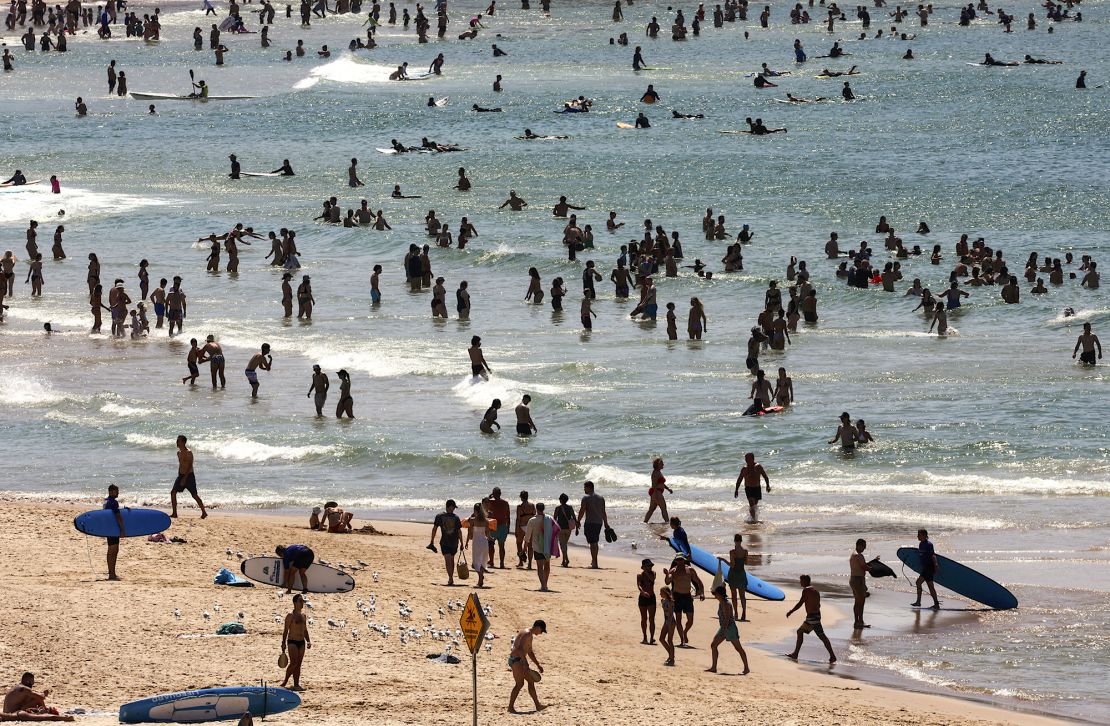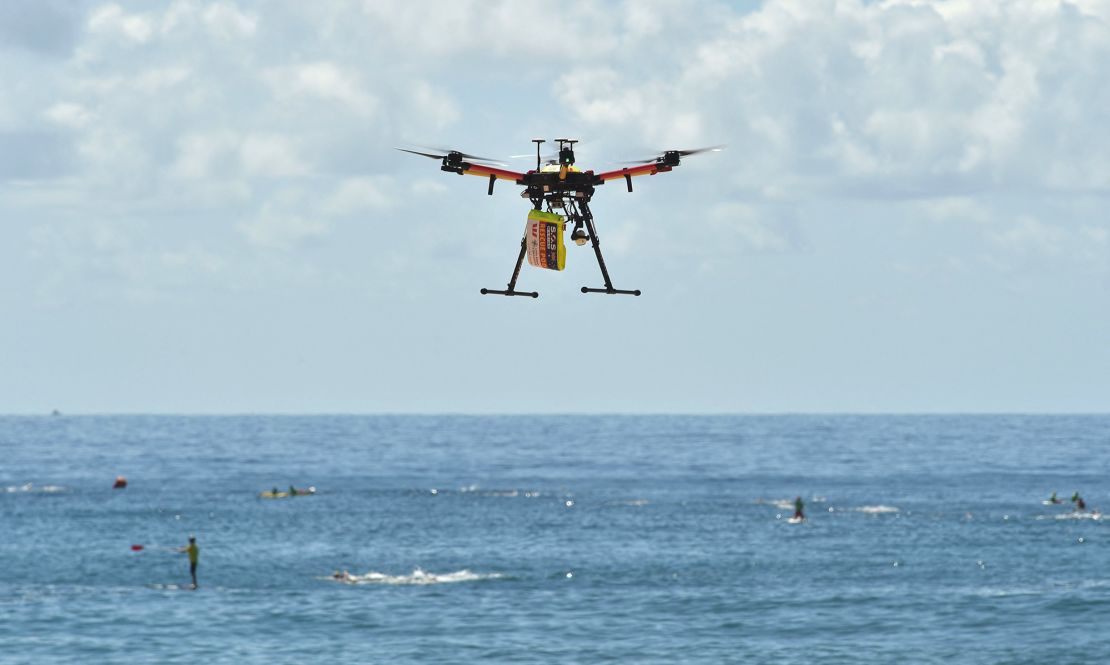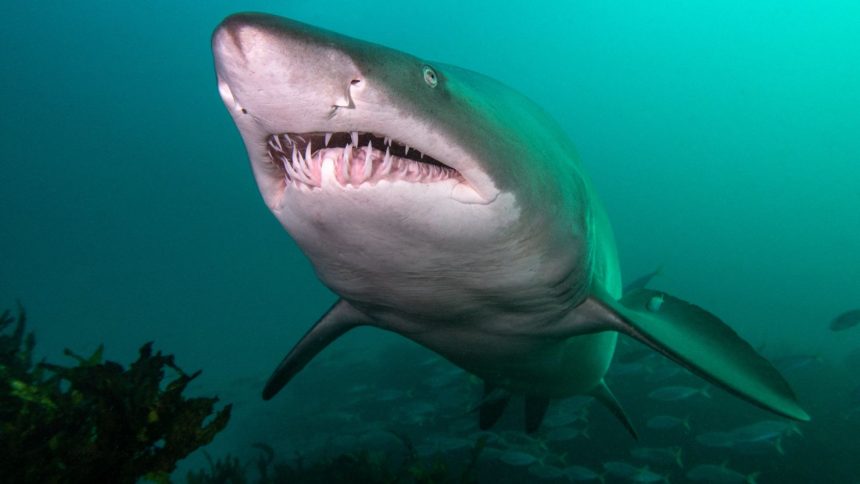CNN
—
Editor’s Note: Call to Earth is a CNN editorial series committed to reporting on the environmental challenges facing our planet, together with the solutions. Rolex’s Perpetual Planet Initiative has partnered with CNN to drive awareness and education around key sustainability issues and to inspire positive action.
In late November, a gaggle of open-water swimmers set out from Sydney’s Bondi Beach. About 500 meters (1,600 feet) from shore, they stopped and formed a line 150 meters (about 500 feet) long, treading water above the length of the beach’s shark net.
They hoped to demonstrate that the length of the net paled in comparison to that of the world-famous kilometer-long beach. And that if they could easily bypass the net, sharks can too.
“It’s a bit of a joke for us when we swim over the top of or around the outside of the shark nets … seeing how utterly useless they are,” Kim Miller, an open-water swimmer based in Sydney, told CNN.
Miller was out of town the day of the protest, but she’s among a growing group of swimmers, surfers, animal welfare advocates, and others vocally opposed to shark nets, which have been used at Sydney’s beaches every summer since 1937.
Opponents of the nets – which are installed at 51 beaches between Newcastle and Wollongong – argue they are ineffective, outdated, and harmful to the ocean ecosystem. They say nets provide swimmers with a false sense of security. Some academic studies back up claims that the nets are not effective at keeping people safe.
From September 2023 to April 2024, 255 marine creatures were entangled in shark nets in New South Wales (NSW). But only 15 of those animals were “target species” like great white, tiger and bull sharks. The rest were rays, turtles, dolphins, fish like longtail tuna, and sharks not considered dangerous.
Marcel Green, the leader of the shark program at the NSW Department of Primary Industries and Regional Development (DPIRD), which manages the nets, told CNN via email that whale alarms and dolphin pingers are used to deter those animals from the nets, and that nets aren’t used during the winter, because it’s the peak of the whale migration season.
This year, amid growing opposition to the nets, they were removed on March 31, a month earlier than normal, due to increased turtle activity in April.
And in recent months, in response to a survey sent out by the NSW government, asking local authorities to vote on the use of shark nets, none of the eight councils where shark nets are used elected to continue their use next season, according to Humane World for Animals.
Now, the state government is set to decide if shark nets have a future in NSW.

Politics over nets
Going to the beach is a popular pastime in Australia, where almost 90% of the population lives within 50 kilometers (30 miles) of the coast. The country’s shoreline is also home to several species of sharks, including tiger, bull, and great white sharks, that are most frequently involved in serious injuries to humans.
NSW has a comprehensive shark management program to try to keep beachgoers safe.
In addition to nets, authorities use technologies like SMART drumlines, which consist of a buoy and a baited hook. When an animal is caught, authorities are alerted. Non-target animals are released, and sharks of target species are tagged and released farther out to sea. Later, if a tagged shark swims close to shore, the public is alerted via an app and updates to an X account. Drone patrols are also a common sight over the state’s beaches.
“If we know that we have more sophisticated measures that are better at protecting sharks, they don’t kill non-target species, so why would we keep the nets in that mix?” Jack Boyd, the mayor of Sutherland Shire council, one of the councils that participated in the survey, told CNN.
“It’s not something that we considered flippantly, it’s not something that’s a response to special interests,” he added. “It is something that is based on science.”
Over the last 10 years there were, on average, 2.8 annual fatalities from shark incidents nationally, 20 cases a year where people were injured, and seven a year where the person was uninjured, according to the Taronga Conservation Society Australia, which works on the Australian Shark-Incident Database.
For comparison, in 2023, 125 people drowned in the ocean, according to Surf Life Saving Australia, and there were 1,266 fatalities on Australian roads over the same period, according to official data.
Since the meshing program began in 1937, there has only been one fatal shark incident at a netted beach, and that was back in 1951, says Green, of NSW DPIRD. He points to a 1997 study that says when they were first introduced, shark nets in NSW, Queensland and South Africa reduced the rate of shark incidents by about 90%.
He added that to date, there has not been a shark bite while drones have been monitoring a beach. (Officials have been trialing the use of drones to detect sharks at NSW beaches since 2017).
According to some experts, shark nets have become a political hot potato. “I do not see anyone concerned with the safety of swimmers and surfers. I see people concerned with the next election and with political survival,” Christopher Pepin-Neff, an associate professor in Public Policy at the University of Sydney, told CNN.

The tensions over the future of shark nets were on full display in late February at a local council meeting in Randwick, home to Coogee, another popular Sydney beach, just a few kilometers south of Bondi.
“They do not form a barrier, deter, deflect, or stop sharks from swimming at beaches,” Lauren Sandeman, a PhD researcher in human and shark interactions, told the council. “Their goal is to entangle and kill whatever swims into the net.”
For others, the risk of changing tack is too great. “If these shark nets were removed and some person is getting mauled by a shark and being killed, I couldn’t face that person’s partner or parent,” said councilor Noel D’Souza, before casting his vote to keep the nets in the water.
Another councilor, Carolyn Martin, who supported the nets told CNN that although it was a tough decision for her personally, her community “just felt safer with the nets in.”
In the end, eight councilors voted to do away with shark nets, beating out the seven councilors who want them to stay.
Saving Norman
The population of grey nurse sharks on Australia’s East coast has dwindled to about 2,000 animals making them critically endangered. The sharks, which can grow over to over three meters (almost 10 feet) in length and have long, scraggly teeth visible even when their mouths are closed, are not considered a threat to divers and swimmers.
“They have this ferocious look about them, and yet they’re these cute, cuddly Labradors,” says Sarah Han-de-Beaux, a Sydney-based free- and scuba diver, who frequently spots the sharks on her outings.
Several years ago, Han-de-Beaux and others started “Saving Norman,” a campaign to advocate for the removal of the nets. (Many Sydney residents refer to grey nurse sharks as “Norman,” a name coined by a local drone photographer).
In recent months, she’s given up most of her weekends to campaign for the removal of the nets, manning booths at local beaches to educate the public.
“People think they stretch the whole beach,” she says, but all shark nets in NSW span 150 meters (about 500 feet) and are just six meters tall.
Han-de-Beaux says that it’s been a year of progress. This summer, the frequency of net inspections went up to every two days from every three days, to increase the possibility of releasing entangled animals alive. (The previous summer, only 36% of the 255 creatures caught in the nets were released alive).
Other measures to protect accidental catch, like installing lights on the nets to deter turtles, were trialed. And in recent weeks, local officials have been posting signs warning the public of the early removal of the nets.

Now, a decision is expected from the New South Wales government on if the nets will go back in next September. Pepin-Neff estimates that the decision might be clear when the next state budget is announced, generally around June.
The government will consider feedback from the surveys it sent out to coastal councils, and other data as it develops its shark management program for the 2025 to 2026 season, according to Green. “Our program is evidence-based after many years of trials and research,” he added.
In the meantime, swimmers like Miller plan to keep taking to the water, nets or not, accepting the risk of entering a shark’s natural habitat.
“Every time I get in the ocean, I assume that there are sharks in there. It’s where they live,” she says. “We’d have to be super unlucky for something to go terribly wrong.”




